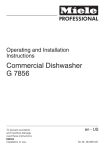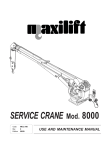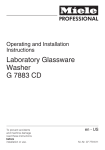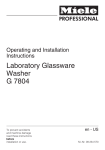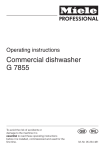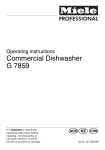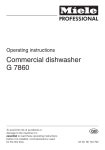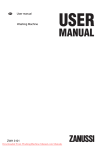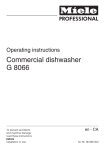Download US - AJ Madison
Transcript
Operating Instructions Commercial Dishwasher G 7859 To prevent accidents and machine damage read these instructions before installation or use. en - US, CA M.-Nr. 07 484 741 Contents IMPORTANT SAFETY INSTRUCTIONS. . . . . . . . . . . . . . . . . . . . . . . . . . . . . . . . . 3 Description of the machine . . . . . . . . . . . . . . . . . . . . . . . . . . . . . . . . . . . . . . . . . . 7 Guide to the machine . . . . . . . . . . . . . . . . . . . . . . . . . . . . . . . . . . . . . . . . . . . . . . 8 Before using for the first time. . . . . . . . . . . . . . . . . . . . . . . . . . . . . . . . . . . . . . . 10 Opening and closing the door . . . . . . . . . . . . . . . . . . . . . . . . . . . . . . . . . . . . . . 11 Water softener . . . . . . . . . . . . . . . . . . . . . . . . . . . . . . . . . . . . . . . . . . . . . . . . . . . 12 Setting the water softener . . . . . . . . . . . . . . . . . . . . . . . . . . . . . . . . . . . . . . . . . . . 14 Filling the salt reservoir . . . . . . . . . . . . . . . . . . . . . . . . . . . . . . . . . . . . . . . . . . . . . 15 Salt indicator . . . . . . . . . . . . . . . . . . . . . . . . . . . . . . . . . . . . . . . . . . . . . . . . . . . . . 16 Loading the machine . . . . . . . . . . . . . . . . . . . . . . . . . . . . . . . . . . . . . . . . . . . . . . 17 Adjusting the upper basket . . . . . . . . . . . . . . . . . . . . . . . . . . . . . . . . . . . . . . . . . . 20 Items not suitable for dishwashers . . . . . . . . . . . . . . . . . . . . . . . . . . . . . . . . . . . . 20 Adding rinse aid . . . . . . . . . . . . . . . . . . . . . . . . . . . . . . . . . . . . . . . . . . . . . . . . . . 21 Setting the dosage. . . . . . . . . . . . . . . . . . . . . . . . . . . . . . . . . . . . . . . . . . . . . . . . . 22 Adding cleaning agent . . . . . . . . . . . . . . . . . . . . . . . . . . . . . . . . . . . . . . . . . . . . 23 Program selection . . . . . . . . . . . . . . . . . . . . . . . . . . . . . . . . . . . . . . . . . . . . . . . . 25 Program chart . . . . . . . . . . . . . . . . . . . . . . . . . . . . . . . . . . . . . . . . . . . . . . . . . . . 26 Switching the machine on and off . . . . . . . . . . . . . . . . . . . . . . . . . . . . . . . . . . . 28 Switching on . . . . . . . . . . . . . . . . . . . . . . . . . . . . . . . . . . . . . . . . . . . . . . . . . . . . . 28 Starting the program. . . . . . . . . . . . . . . . . . . . . . . . . . . . . . . . . . . . . . . . . . . . . 28 Changing a program . . . . . . . . . . . . . . . . . . . . . . . . . . . . . . . . . . . . . . . . . . . . 29 Selecting an additional function . . . . . . . . . . . . . . . . . . . . . . . . . . . . . . . . . . . . 29 Program sequence indicator . . . . . . . . . . . . . . . . . . . . . . . . . . . . . . . . . . . . . . 29 Switching off . . . . . . . . . . . . . . . . . . . . . . . . . . . . . . . . . . . . . . . . . . . . . . . . . . . . . 29 Cancelling a program . . . . . . . . . . . . . . . . . . . . . . . . . . . . . . . . . . . . . . . . . . . . . . 30 Programming special functions . . . . . . . . . . . . . . . . . . . . . . . . . . . . . . . . . . . . . 31 Cleaning and care . . . . . . . . . . . . . . . . . . . . . . . . . . . . . . . . . . . . . . . . . . . . . . . . 38 Correcting minor faults . . . . . . . . . . . . . . . . . . . . . . . . . . . . . . . . . . . . . . . . . . . . 42 After Sales Service. . . . . . . . . . . . . . . . . . . . . . . . . . . . . . . . . . . . . . . . . . . . . . . . . 43 Installation . . . . . . . . . . . . . . . . . . . . . . . . . . . . . . . . . . . . . . . . . . . . . . . . . . . . . . 44 Electrical connection . . . . . . . . . . . . . . . . . . . . . . . . . . . . . . . . . . . . . . . . . . . . . . 46 Plumbing. . . . . . . . . . . . . . . . . . . . . . . . . . . . . . . . . . . . . . . . . . . . . . . . . . . . . . . . 47 Technical data . . . . . . . . . . . . . . . . . . . . . . . . . . . . . . . . . . . . . . . . . . . . . . . . . . . 49 Caring for the environment . . . . . . . . . . . . . . . . . . . . . . . . . . . . . . . . . . . . . . . . . 50 2 IMPORTANT SAFETY INSTRUCTIONS WARNING When using your dishwasher follow basic precautions, including the following: This dishwasher is only intended for specialized applications. Only use the machine for its intended purpose. Any other use, conversion or modification is dangerous. The manufacturer cannot be held responsible for damages caused by improper use of this machine. This dishwasher complies with current safety requirements. Improper use of the machine can lead to personal injury and material damage. Read all instructions before installing or using this machine. Keep these operating instructions in a safe place and pass them on to any future user. Installation and service ~ Installation and repair work should be performed by a Miele authorized service technician. Work by unqualified persons could be dangerous and may void the warranty. ~ Do not use the machine until properly installed. ~ Do not install the machine in an area where a danger of explosion or of freezing temperatures may be present. ~ The installation of this unit in non-stationary locations (e.g. ships) must be performed by a qualified installer or service agency, in strict accordance with national and local safety regulations and standards. ~ Before installation, make sure that the voltage and frequency listed on the data plate correspond with the household electrical supply. This data must correspond to prevent injury and machine damage. Consult a qualified electrician if in doubt. ~ Be certain this machine is properly installed and grounded by an authorized technician. To guarantee the electrical safety of this machine, continuity must exist between the machine and an effective grounding system. It is imperative that this basic safety requirement be met. If there is any doubt, have the electrical system checked by a qualified technician. The manufacturer cannot be held responsible for damage or injury, such as electric shock, caused by missing or defective grounding. 3 IMPORTANT SAFETY INSTRUCTIONS ~ Do not install or use a damaged dishwasher. A damaged machine is dangerous. Unplug the machine and call your Miele dealer or the Miele Technical Service Department. ~ If the power cord is damaged it must only be replaced by a Miele Service technician with a genuine Miele power cord. ~ Do not use an extension cord to connect this machine to electricity. Extension cords do not guarantee the required safety of the machine (e.g. danger of overheating). ~ Defective components should be replaced by Miele original parts only. Only with these parts does the manufacturer guarantee that they comply with safety requirements. ~ Before installation or service, disconnect the power supply to the work area by unplugging the unit, "tripping" the circuit breaker or removing the fuse. ~ When work has been performed on the supply plumbing, the supply line to the commercial dishwasher must be bled. Otherwise, the water softening system may be damaged. 4 Use ~ Please follow the advice on installation in this manual and in the separate Installation Instructions. ~ Personnel operating the machine should be trained regularly. ~ Persons who lack physical, sensory or mental abilities, or experience with the machine should not use it without supervision or instruction by a responsible person. ~ Do not allow children to play in or around the dishwasher, or to operate it. ~ Do not tamper with the controls. ~ BURN AND SCALD HAZARD This dishwasher reaches very high temperatures. Take care when unloading the unit. Let baskets and inserts cool before touching them. Any water which may remain in containers will be very hot and should be emptied into the wash cabinet. ~ BURN HAZARD The heating elements become extremely hot during use. Do not touch the heating elements during or directly after the end of a program. ~ Take care when handling liquids such as detergent, rinsing, wetting, or neutralizing agents. These may contain irritant or caustic ingredients. Do not use any organic solvents. Danger of explosion! Follow the instructions and relevant safety procedures carefully. Wear protective gloves and goggles. The manufacturer’s safety conditions must be observed with all chemical agents. IMPORTANT SAFETY INSTRUCTIONS ~ Under certain conditions, hydrogen gas may be produced in a hot water system that has not been used for two weeks or more. HYDROGEN GAS IS EXPLOSIVE. If the hot water system has not been used for such a period, turn on all hot water faucets and let water flow from each for several minutes before using the dishwasher. This will release any accumulated hydrogen gas. Do not smoke or use an open flame during this time. ~ Use only rinse agents for ~ Avoid inhaling detergent. If swallowed, it can cause burning in the mouth and throat or inhibit breathing. ~ When a chemical additive is ~ Be careful when sorting and loading items to be washed: locate sharp items so that they are not likely to damage the door seal; and load sharp knives with the handles up to reduce the risk of injuries. ~ The water in the machine must not be used as drinking water. ~ Do not sit or lean on the open door. This could cause the machine to tip or be damaged. ~ Never clean the machine or near its vicinity with a water or high pressure hose. ~ Only use cleaning agents formulated for special processes and approved by Miele for use with this machine. Keep all cleaning agents out of the reach of children. Use of unsuitable cleaning agents could adversely affect the components of the machine. commercial dishwashers. When other rinse agents are used, there is the danger that the rinse load and the dishwasher might be damaged. ~ Pre-treatments with detergents can create suds, as can certain rinsing agents. For pre-treatment and / or cleaning only, use low-sudsing detergents which have been approved by Miele. Suds can have an adverse effect on the cleaning process. recommended on technical application grounds (e.g. with a detergent), this does not imply that the manufacturer of the dishwasher takes responsibility for the affect of the chemical on the material of the items being cleaned. Please be aware that changes in formulation, storage conditions, etc., which may not be publicized by the chemical producer, can have a negative effect on the cleaning result. ~ Always follow the instructions of the chemical manufacturer when using detergents and special application chemicals. Only use such chemicals for the purpose and in the situation specified to avoid such dangers as chemical reactions and material damage. ~ The dishwasher is designed only for operation with water and additive cleaning agents. Organic solvents must not be used in the machine. An explosion or machine corrosion could occur with the use of organic solvents. 5 IMPORTANT SAFETY INSTRUCTIONS ~ In critical applications where very stringent requirements must be met, it is highly recommended that all relevant factors for the process, such as cleaning agent, quality of water, etc., be discussed with a Miele Application Specialist. ~ The special inserts should only be used for their specific application. ~ Do not wash plastic items unless they are marked "dishwasher safe" or the equivalent. If in doubt follow the manufacturers recommendations. ~ Empty any containers or utensils before arranging them in the machine. ~ Do not allow any remains of acids or solvents, particularly hydrochloric acid or chloride solutions, to get into the wash cabinet. The presence of any solvents should be minimized (especially those in hazard class A1). ~ To avoid corrosion damage ensure that solutions or steam containing hydrochloric acid do not come into contact with the steel outer casing of the machine. Disposal of the old machine ~ When disposing of your old dishwasher first make it unusable. Disconnect it from the mains power supply, cut off the cable and plug from the cable. ~ For environmental and safety reasons ensure the machine is completely drained of any residual water and detergent. (Observe safety regulations and wear safety goggles and gloves). ~ Remove the door to the washing compartment, so that children cannot accidentally shut themselves in. Make appropriate arrangements for the safe and environmentally responsible disposal of the machine. ~ For tank system machines ensure that all water is emptied out the tank. The manufacturer cannot be held responsible for any damage caused by non-observance of these Important Safety Instructions. Accessories ~ Only specific additional equipment, made by Miele or approved by Miele, should be connected to this machine. Consult Miele on the type and application of such equipment. 6 ~ SAVE THESE INSTRUCTIONS Description of the machine This Miele machine is a frontloading commercial dishwasher, with very short batch times especially suitable for use in restaurants, cafés, fast food outlets, boarding houses, etc. It operates on the freshwater system and is equipped with a water softener and electro-thermal door lock as standard. Standard ^ Steam condenser (DK) 7 Guide to the machine a On/Off button (I-0) b Door release c Display d “Delay start” indicator light (see “Programming special functions”) e “Drying” indicator light f “Program start” indicator light g Start button h Drying button i Switch to change display from “Actual temperature” to “Elapsed program time” 8 j Optical interface (for service technician) k “Add (liquid) detergent”indicator light (only where special DOS module is connected externally) l “Add rinse aid” indicator light m “Reactivate water softener” indicator light n “Check water inlet/outlet” indicator light o Program sequence indicators p Program selector Guide to the machine a Connection for DOS dispenser module at the rear (Dispenser pump for liquid detergent) d Dispenser for powder detergent e Dispenser for rinse aid (with dosage selector) b Filter combination c Salt reservoir (Water softener) 9 Before using for the first time Load the machine carefully Before using for the first time please pay special attention to the following points. Detailed information on these points can be found in the relevant sections of these Operating Instructions. Set the water softener unit The water softener unit must be set for the water hardness level in your area. The salt reservoir also has to be filled, first with water and then with reactivation salt. ,Filling the salt reservoir with cleaning agent by mistake will cause serious damage to the water softener. Please check every time before refilling that the package contains reactivation salt. Add rinsing agent ,Inadvertently filling the reservoir for rinsing agent with cleaning agent (including liquid cleaning agents and washing up liquid) will cause serious damage to the reservoir. Only use designated cleaning agents for special applications. Do not use cleaning agents formulated for use in domestic dishwashers. 10 Arrange the load so that water will come into contact with all surfaces. Concealed surfaces will not be cleaned. The spray arms must not be blocked by any items. Adding cleaning agent Follow the cleaning agent manufacturer’s recommendations on dosage. The amount required will depend on the type of cleaning agent and the programme chosen. Make sure you read the notes on dosing given in the program chart. Cleaning results may vary from brand to brand. If you are not satisfied with the results from one brand try another quality brand before contacting Miele for advice. The filter combination at the base of the wash cabinet and the spray arms must be kept clean. Regular checking and cleaning is essential. Opening and closing the door Electric door lock Cancelling a program The machine is equipped with an electric door lock. If a program has to be cancelled in extreme cases, e.g. when articles in the machine jostle against each other or the program is interrupted with a fault indication, the door must be opened (deliberate intervention): The door can only be opened when: ^ the machine is connected electrically ^ the main switch I-0 is on. To open the door a ^ Press the door button in fully and at the same time pull open the door. ,Do not touch the heating elements if you open the door during or directly after the end of a program. The heating elements remain hot for some time after the end of a program. To close the door ^ Lift the door upwards until it clicks into position. Do not push in the door release button as you do so. ^ Turn the program selector switch to f (the program is cancelled after approx. 2 secs.). Important: Further procedures are described in the section “Switching on and off” under “Cancelling a program”. Opening the door with the emergency release The emergency release should only be used when the door cannot be opened normally (e.g. power failure). ^ Turn the program selector switch to f. ^ Switch off the machine (I-0 switch). The door is locked approx. 1.5 mins. after program start, except in the program D (PRE-RINSE), 6 (DRAIN) and during the drying phase (additional program). The door remains locked until the end of the program, when it can be opened again. ^ Pull down the emergency release behind the door outer panel. 11 Water softener To avoid the build-up of calcium deposits on items being cleaned and in the machine the water needs to be softened. To ensure a steady supply of soft water the water softener unit must always be: 1. correctly set (programmed) and 2. the salt reservoir must be filled. (If the water hardness level is below 70 mg/l (4 °d - German scale) the water does not need to be softened.) The machine is set at the factory for a water hardness level of 340 mg/l (19 °d). If the water supply is harder or softer than this (including below 70 mg/l or 4 °d) the factory setting will need to be changed following the instructions in the section "Setting the water softener". For settings see chart on the next page. Your local water authority will advise you on the water hardness in your area. For fluctuating levels (e.g. 140 - 310 mg/l or 8 - 17 °d) set the water softener to the highest setting (in this example to 310 mg/l or 17 °d). Important The built-in water softener has settings from 20 mg/l to 1080 mg/l or 1 °d 60 °d. 12 For future servicing it is useful to make a note of your water hardness level. ^ Enter details of your water hardness level here: °d / mg/l Water softener Table of settings °d (German scale) mg/l °f Setting 1 2 3 4 5 6 7 8 9 10 11 12 13 14 15 16 17 18 19 *) 20 21 22 23 24 25 26 27 28 29 30 31 32 33 34 35 36 37 38 39 40 41 42 43 44 45 20 40 50 70 90 110 130 140 160 180 200 220 230 250 270 290 310 320 340 360 380 400 410 430 450 470 490 500 520 540 560 580 590 610 630 650 670 680 700 720 740 760 770 790 810 2 4 5 7 9 11 13 14 16 18 20 22 23 25 27 29 31 32 34 36 38 40 41 43 45 47 49 50 52 54 56 58 59 61 63 65 67 68 70 72 74 76 77 79 81 1 2 3 4 5 6 7 8 9 10 11 12 13 14 15 16 17 18 19 20 21 22 23 24 25 26 27 28 29 30 31 32 33 34 35 36 37 38 39 40 41 42 43 44 45 °d (German scale) mg/l °f Setting 46 47 48 49 50 51 52 53 54 55 56 57 58 59 60 830 850 860 880 900 920 940 950 970 990 1010 1030 1040 1060 1080 83 85 86 88 90 92 94 95 97 99 101 103 104 106 108 46 47 48 49 50 51 52 53 54 55 56 57 58 59 60 *) factory setting Machines without a water softener are set to "0" at the factory. This setting of "0" must not be changed on these machines. 13 Water softener Setting the water softener ^ Switch the machine off. ^ Turn the program selector to f "STOP". ^ Press 4 and 6 at the same time, hold them in and while doing so switch on the machine with the I-0 mains switch. The actual program status "P..." appears in the display. The p / 6 indicator light illuminates. ^ Press 3 once, and "E01" (program level 1) appears in the display. ^ Turn the program selector six switch positions to the right (6 o’clock position). The number "19" appears in the display (the factory water hardness setting in °d), (equivalent to 340 mg/l). ^ Press 4 as many times as is necessary, or hold it in until the required value (degree of hardness in °d) appears in the display. The counter returns to "0" after reaching "60". ^ Press 6. "SP" appears. ^ Press 6 once more. The setting will now be stored. The display clears. ^ The machine is now ready for operation. 14 Water softener Filling the salt reservoir ^ Place the funnel provided in place. Please only use special coarse grained reactivation salt with granules of approx. 1-4 mm. Do not use other types of salt, e.g. table salt, agricultural or gritting salt. These could contain components which are insoluble in water which could result in damage to the water softener. If in doubt consult your Miele Professional Department. ^ Fill carefully with salt, (as it is filled water will run out). The salt reservoir holds approx. 2.5 kg of salt. ,Inadvertently filling the salt reservoir with cleaning agent will damage the water softener. Before filling the salt reservoir make sure that you have picked up the right packet of reactivation salt. ^ Remove the bottom basket from the machine. ^ Unscrew the salt reservoir cap. Before filling the salt reservoir with reactivation salt for the first time fill it with approx. 2.5 liters of water. ^ Wipe any residual salt off the screw threads on the socket. ^ Screw the cap on firmly. ^ Immediately after this: Run the "Pre-Rinse" D program to remove any traces of salt from the cabinet. Important: If after starting the "PRE-RINSE" program D the machine does not start for a few minutes this is not a fault. The water softener is being reactivated. 15 Water softener Salt indicator When the salt reservoir is empty the k indicator light b comes on to remind you to fill the reservoir. Reactivation takes place automatically during a program. The program sequence indicator light a, k lights up while this is happening. 16 Loading the machine Loading the machine Preparation ^ Empty all containers before loading into the machine. ,Ensure that no acid or solvent residues, especially hydrochloric acid or chlorides get into the wash cabinet. Notes ^ Load items so that water will come into contact with all surfaces. This ensures that they will be properly cleaned. ^ Do not place items to be cleaned inside other pieces where they may be concealed. ^ Hollow vessels such as cups, glasses, pots etc. should be inverted and placed in the correct inserts. ^ Deep based items should be placed at an angle to ensure that water runs freely off them. ^ Tall, narrow, hollow pieces should be placed in the centre of the basket to ensure good coverage of water. ^ Small pieces should be placed on the cup racks in the upper basket. Do not obscure them by larger items below. Cups should be on the lower rack and bowls on the top rack so that water reaches all pieces. ^ The water duct for the spray arm in the middle of the upper basket must not be covered. ^ The spray arms must not be blocked by items which are too tall or which hang down in their path. If necessary, manually rotate the arms to test. Use the upper basket for: ^ small, lightweight, delicate items such as cups, saucers, glasses, dessert bowls etc. as well as for lightweight thermally stable plastic items. Use the bottom basket for: ^ larger and heavier items such as plates, serving platters, saucepans, bowls etc. Glasses may only be cleaned in the bottom basket if it is fitted with a special glassware insert or if there is a special bottom basket. Cutlery ^ Unsorted cutlery should be placed in the cutlery holders with the handles facing downwards. Select baskets and inserts which are appropriate for the application. See examples on the following pages 17 Loading the machine Loading examples: Individual upper and bottom baskets O 881 Upper basket for 20 cups, 24 saucers or 12 dessert plates. O 889 Upper basket carrier to take various inserts, e.g. containers for cutlery and glasses. U 880 Bottom basket with 2 x E 216 half inserts each for 15 plates Ø 240 mm and 2 x E 165 cutlery baskets for mixed cutlery. U 880 Bottom basket with E 884 insert 1/1 for 20 large plates or 10 trays. 18 Loading the machine Glass-Set GG/F-GL O 882 Upper basket for 27 glasses Ø 65 mm. U 880 Bottom basket with 2 x E 205 half inserts each for 14 glasses Ø 65 mm. 19 Loading the machine Adjusting the upper basket The upper basket can be adjusted above and below the middle position by 2.5 cm. It is set in the middle position on delivery. Items not suitable for dishwashers – Cutlery with wooden or horn handles. – Wooden or plastic cutting boards. Depending on the position of the upper basket, plates of the following diameter can be accommodated in the baskets: – Glued items, e.g. old knives with handles which have been glued on. Example: Upper basket O 881 – Copper or tin items. Upper basket position Bottom Upper basket basket plate Ø cm plate Ø cm top max. 16.5 24 *) middle max. 19 24 *) bottom max. 21.5 24 *) *) in insert E 216. For plates up to Ø 30 cm use insert E 888. – Hand-made craft items. – Plastic items which are not heat resistant. Please note – Silver and aluminium items can suffer some discolouration. – Colours painted over a glaze may fade after a number of washes. – Clouding may occur on glasses after frequent washing. Our recommendations To adjust the upper basket: ^ Pull the upper basket out until a resistance is felt, lift from the runners and remove. ^ Unscrew the knurled nuts (roller bearings) on both sides of the basket with a No. 7 spanner and reposition as required. 20 – Wash delicate glassware by hand. – When purchasing new glasses, dishes and cutlery make sure they are dishwasher safe. Adding rinse aid Rinse aid is necessary to ensure that water does not cling and leave marks on utensils during the drying phase. Rinse aid is poured into the storage reservoir and the amount set is dispensed automatically in the final rinse. The rinse aid reservoir holds approx. 125 ml. ,Inadvertently filling the rinse aid reservoir with powder detergent (or liquid detergent) always causes serious damage to the reservoir. Only use rinse aid formulated for this machine. Adding rinse aid If the indicator light H “Add rinse aid” on the control panel comes on, the rinse aid reservoir must be refilled. ^ Open the door fully. ^ Press the button in the direction of the arrow until the flap springs open. 21 Adding rinse aid Setting the dosage ^ Add rinse aid only until the surface is visible in the opening. ^ Close the flap firmly. The flap must audibly engage, otherwise water could get into the rinse aid reservoir during the program. ^ Mop up any spilt rinse aid. This prevents over-foaming occuring during the next program. The flap should always remain closed. Only open it to add more rinse aid. ^ Wait until the rinse aid indicator light H on the control panel lights up again before adding any more rinse aid. 22 The dosage adjuster (see arrow) in the opening has settings adjustable from 1 to 6 (1-6 ml). It is set to “3" (3 ml) at the factory as the recommended dose. ^ If there are flecks on utensils after drying use a higher setting. ^ If clouding or smearing occurs on utensils after drying use a lower setting. Adding cleaning agent ,Only use cleaning agents formulated for specialist machines. Do not use detergents formulated for domestic dishwashers. Powder cleaning agent is dispensed via the dispenser for powder cleaning agents in the door or liquid cleaning agent via the DOS-Module (available as an optional extra - see "Note" on the next page). If liquid cleaning agent is not being used then, powder cleaning agent must be placed in the detergent container prior to every program (except D "PRE-RINSE") (see also the note in the "program chart"). ^ Add powder cleaning agent to compartment II. Dosage: approx. 3 g/l, corresponding to approx. 20 g per cleaning stage. During the "Cleaning (main wash)" stage approx. 7 litres of water are used. Follow manufacturer’s instructions if they differ. ^ Close the dispenser lid. Under certain circumstances, i.e. special soiling, different combinations of cleaning agents and other additives may be necessary. The Miele Professional Department will be pleased to advise you. ^ Press the opening catch on the container flap (see arrow) forwards. The flap will spring open. (The flap is always open at the end of a program). 23 Adding cleaning agent Note As a chargeable optional extra this machine can also be fitted with a "dispenser pump for liquid cleaning agent" (DOS-Module G 60). This is connected externally. See "Programming special functions" for information on venting the dispensing system and setting the dosage. See separate instructions for "Installation and connection of the optional DOS Module" Dispensing system maintenance To ensure safe functioning maintenance work should be carried out at specified intervals. The work should only be carried out by a Miele authorized and trained service technician or other suitably qualified and competent person. 1 - 1 1/2 yearly Exchange the hoses in the dispensing systems / DOS-Modules. 24 ,Take great care when handling liquid agents. They may contain acids, leaches or disinfectant. Please follow the safety instructions. Wear protective goggles and gloves if necessary. Program selection Choose your program according to the type of instruments or utensils being cleaned and the degree of soiling. The different programs and their uses are described overleaf in the Program chart. 25 Program chart Program When to use Detergent (when not using liquid detergent) Observe the manufacturer’s instructions D PRE-RINSE To rinse heavily soiled items (e.g. for removing soiling or to prevent soiling drying on to dishes when a full program does not yet need to be run). p SHORT “Quick program” for lightly soiled crockery. 20 grams in the powder dispenser q UNIVERSAL For normally soiled crockery. 20 grams in the powder dispenser r INTENSIVE For heavily soiled crockery. The soiling is removed in an intensive cold water pre-rinse. 20 grams in the powder dispenser 6 DRAIN For draining away cleaning water, e.g. when a program has been interrupted. The program selector must be at f “STOP”. 26 Program chart Program sequence 1. Preliminary pre-wash 2. Pre-wash 3. Main wash 4. Economy Interim rinse 5. Interim rinse I 6. Interim rinse II 2) 7. Final rinse 8. Drying phase (Extra prog.) (X) X 85°C/1’ (X) X X X 65°C/1’ 1) X X 65°C/1’ 1) X (X) X 85°C/1’ 1) X X X 65°C/3’ (X) 1) X (X) X 85°C/1’ 1) (X) 1) X = sections included in a program (with temperature/temperature holding time) 1) 2) To change a temperature or temperature holding time see “Programming special functions”. To select a second interim rinse II see “Programming special functions”. 27 Switching the machine on and off Switching on ^ Close the door. ^ Open the stopcocks (if turned off) . ^ Press the I-0 button. When the program selector is at the f “STOP” position a point lights up in the display. Starting the program ^ Turn the program selector clockwise or anti-clockwise to the required program. The wash temperature of the selected program is shown in the display, except with D (PRE-RINSE) and 6 (DRAIN). ^ Select additional function 3 (DRYING) if required, (see “Selecting an additional function”). ^ Press the 6 “Start” button. The display will now show the actual temperature. The indicator light next to the “Start” button comes on. 28 Once the program has started, all other programs are blocked. If the program selector is then turned to another program, the values shown in the display go out. The values can be seen again only if the program selector is turned back to the position of the program currently in operation. ^ Press the 4 button to alternate the display between elapsed time and actual temperature. Note that during the heat-up stage in “Main wash” and “Final rinse” the desired temperature is shown in the elapsed time display. Switching the machine on and off Changing a program Program end Provided the “Start” button has not yet been pressed, a wrongly selected program may be changed as described below, (if it has been pressed see “Cancelling a program”): The program has ended when no more program sequence indicators are lit up and the “Start” indicator light 6 has gone out. An “0" is shown in the middle of the display. Use the 4 button to see how long a program has to run or to see the actual temperature. ^ Turn the program selector to the required function. ^ Select additional function 3 (DRYING) again if required (see “Selecting an additional function”). ^ Press the “Start” 6 button. Selecting an additional function The following additional function can be selected: ^ 3 DRYING “Drying” may be selected as an additional function as soon as a program has been selected (except with D “PRE-RINSE” and 6 “DRAIN”). The drying phase operates with pulsed heating for 10 minutes. The total running time of the program is lengthened accordingly. Switching off ^ Press in and release the I-0 button. As the machine is fitted with an electric door lock, the door can only be opened if the I-0 button is pressed in (see “Opening and closing the door”). Program sequence indicator The indicator light for the active program stage lights up during the program. k Reactivation I Pre-rinse l Main wash m/H Interim rinse / Final rinse c Drying (additional function) 29 Switching the machine on and off Cancelling a program Once a program is running it should only be cancelled in extreme cases, e.g. when articles in the machine rattle or bump against each other and have to be rearranged. ^ Turn the program selector to the f position (the program is cancelled after approx. 2 secs.). ^ Open the door a. ,Take care! Water and items in the machine may be hot, there is a danger of scalding or burning. ^ Replace the articles securely and correctly. (Wear protective gloves where necessary, and observe appropriate health and safety regulations relating to infectious diseases). ^ Replenish (powder) detergent if necessary. ^ Close the door. ^ Select program 6 (DRAIN), (wash water is pumped away). ^ Select the cleaning program again and start it as previously described. 30 Programming special functions 2. Selecting a second interim rinse In the event of a service call at a later date, any changes made to the factory setting should be documented here. Make a note of any changes made in the “Value set: ” box. 1. Setting the cold water inlet from: “Nominal water intake” to “Nominal water intake + 1 l”. The amount of water taken into the machine at each intake can be increased by 1 litre to a maximum of 9.5 litres. Proceed as follows: ^ Turn the program selector to the f “STOP” position. ^ Switch off the machine. ^ Press 4 and 6 at the same time, hold them in and while doing so switch the machine on with the I-0 button. The current program status “P...” appears in the display. The p / 6 indicator light comes on. ^ Press 3 once, “E01" (programming level 1) appears in the display. ^ Turn the program selector to the p position, “10" or ”11" appears in the display. “10" = Nominal water intake ”11" = Nominal water intake + 1 l A second interim rinse can be programmed in to improve interim rinsing in all programs (except D COLD). ^ Turn the program selector to the f “STOP” position. ^ Switch off the machine. ^ Press 4 and 6 at the same time, hold them in and while doing so switch the machine on with the I-0 button. The current program status “P...” appears in the display. The p / 6 indicator light comes on. ^ Press 3 once, “E01" (programming level 1) appears in the display. ^ Turn the program selector to r , “30" or ”31" appears in the display. “30" = One interim rinse. ”31" = Two interim rinses. ^ Press 4 to change from “30" to ”31" or vice versa. ^ Press 6. “SP” appears in the display. ^ Press 6 again. The change has been recorded. Value set: ^ Press 4 to change from “10" to ”11" or vice versa. ^ Press 6. “SP” appears in the display. ^ Press 6 again. The change has been recorded. Value set: 31 Programming special functions 3. Delay start and setting the delay start time The start of a wash program can be delayed by up to 9 hours and 30 minutes in 30 minute stages. Delay start should only be selected with the Universal and Intensive programs. Items in the machine stand for a longer period before being cleaned and residues can dry on if the start time is delayed. Delaying the start time in shorter programs can impair cleaning results. a) To activate delay start ^ Turn the program selector to the f “STOP” position. ^ Switch off the machine. ^ Press 4 and 6 at the same time, hold them in and while doing so switch the machine on with the I-0 button. The current program status “P...” appears in the display. The p / 6 indicator light comes on. ^ Press 3 once, “E01" (programming level 1) appears in the display. ^ Turn the program selector to the 8 o’clock position. “80" or ”81" appears in the display. “80" = Delay start not selected. ”81" = Delay start activated. ^ Press 4 to change from “80" to ”81" or vice versa. 32 ^ Press 6. “SP” appears in the display. ^ Press 6 again. The change has been recorded. Value set: b) Setting the delay start period The delay start period (from 30 minutes to 9 hours and 30 minutes) must be set before a program is started. ^ After selecting a program (see “Switching on”), press the 4 button or hold it in until the required value is displayed. The “Delay Start” indicator light comes on. After the “Start” button 6 is pressed, the delay start period will count down in the display until the program automatically starts. Programming special functions 4. Venting and setting the dosage on “DOS module G 60 or C 60" (special version) ^ Set the dosage selector on the DOS module to the “10" position (on DOS module C 60 only). ^ Turn the program selector to the f “STOP” position. ^ Switch off the machine. ^ Press 4 and 6 at the same time, hold them in and while doing so switch the machine on with the I-0 button. The current program status “P...” appears in the display. The p / 6 indicator light comes on. ^ Press 3 twice, “E02" (programming level 2) appears in the display. Venting the dispensing system: ^ Turn the program selector to the p position. “do1" appears in the display. Setting the dosage: Set the amount to dispense according to the detergent manufacturer’s recommendations. The machine needs 7 litres of water in the “Main wash” program stage. Example: The detergent manufacturer recommends 4 ml cleaning agent per litre of water. 7 l x 4 ml/l = 28 ml. 2 ml . 1 sec. dispensing time; i.e. programming to 14 secs. ^ Turn the program selector to the q position, the dispensing time in seconds appears in the display, e.g “10". ^ Press 4 repeatedly or hold it in, until the number “14" appears in the display (dispensing time 14 seconds . 28 ml - see example). The dispensing time/amount is set. ^ Press 4 for 90 seconds. The dispensing system is vented. Having changed a value or all values: If only venting is required: ^ Press 6 again. The change has been recorded. ^ Switch the machine off with the I-0 button. ^ Immediately after this: start the D (COLD) program, so that after venting any agents in the wash cabinet are diluted before being drained away. ^ Press 6. “SP” appears in the display. Value set: If the dispensing system also needs to be vented: ^ Start the D (DRAIN) program, so that after venting any agents in the wash cabinet are diluted before being drained away. 33 Programming special functions 5. Altering the wash temperature and/or the temperature holding time in the “Main wash” and “Final rinse” program stages In the event of a service call-out, assist the service technician by making a note of any change to the wash temperature and / or the temperature holding time in the “Program chart”. Factory settings for the main wash temperature and temperature holding times and for the final rinse temperature and its holding time are given in the program chart. The main wash and final rinse temperatures can be set from 30°C 70°C and the temperature holding time from 1 to 10 minutes. ^ Turn the program selector to the f “STOP” position (the programming level is displayed only in this switch position). ^ Switch off the machine. ^ Press 4 and 6 at the same time, hold them in and while doing so switch the machine on with the I-0 button. The current program status “P...” appears in the display. The p / 6 indicator light comes on. 34 "Main wash" temperature: ^ Press 3 three times, “E03" (programming level 3) appears in the display. ^ Turn the program selector to the program which needs to be changed. The actual value appears in the display after °C. ^ Press 4 or hold it in, until the required value appears in the display. "Main wash" temperature holding time: ^ Turn the program selector to the f “STOP” position (the programming level is only displayed in this switch position). ^ Press 3 again, “E04" (programming level 4) appears in the display. Then: ^ Turn the program selector back to the program which needs to be changed. The actual value appears in the display after min. ^ Press 4 until the required value appears in the display. Programming special functions "Final rinse" temperature: ^ Turn the program selector to the f “STOP” position (the programming level is displayed only in this switch position). ^ Press 3 again, “E05" (programming level 5) appears in the display. Then: ^ Turn the program selector back to the program which needs to be changed. The actual value appears in the display after °C. ^ Press 4 or hold it in, until the required value appears in the display. "Final rinse" temperature holding time: ^ Turn the program selector to the f “STOP” position (the programming level is only displayed in this switch position). ^ Press 3 again, “E06" (programming level 6) appears in the display. Then: ^ Turn the program selector back to the program which needs to be changed. The actual value appears in the display after min. ^ Press 4 until the required value appears in the display. Having changed a value or all values: ^ Press 6. “SP” appears in the display. ^ Press 6 again. The change has been recorded. 35 Programming special functions 6. Audible tone (Buzzer) This special function allows you to programme a buzzer (lasting up to a maximum of 30 seconds) for the following functions: ^ Press 6 again. The change has been recorded. Value set: – Programme end = Constant buzzer Note: The buzzer can be switched off early by – Fault warning = Buzzer at one second intervals – turning the programme selector to the STOP position f, ^ Turn the programme selector to STOP f. – interrupting the power supply (e.g. by opening and closing the door). ^ Switch the machine off. ^ Press and hold 4 and 6 at the same time, and whilst doing so switch the machine on with the I-0 button. The current programme status “P...” appears in the display and the p / 6 indicator lights up. ^ Press 3 once. E01 for programming level 1 will appear in the display. ^ Turn the programme selector nine switch positions clockwise (9 o’clock position). A number from 90 to 93 will appear in the display. 90 = buzzer switched off. 91 = buzzer at end of programme (standard setting) 93 = buzzer for all functions (at end of programme and for faults). ^ Press 4 until the required function is displayed. ^ Press 6. SP appears. 36 Programming special functions 7. Re-setting all changes back to the factory setting. ^ Turn the program selector to the f “STOP” position. ^ Switch off the machine. ^ Press 4 and 6 at the same time, hold them in and while doing so switch the machine on with the I-0 button. The current program status “P...” appears in the display. The p / 6 indicator light comes on. ^ Press 3 seven times, “E07" (programming level 7) appears in the display. ^ Turn the program selector to any setting (except “STOP”). “00" or ”PP" appears in the display. “00" = factory setting (the electronic unit has not been reprogrammed). ”PP" = the electronic unit has been reprogrammed. ^ If “PP” is displayed, press 4 to change from “PP” to “00". ^ Press 6. “SP” appears in the display. ^ Press 6 again. Values which had been changed are now reset. Important If the hardness level setting in the water softener had been changed this will reset to the factory setting of 340 mg/l (19 °d). This will need to be reset to suit the hardness level in your area. 37 Cleaning and care Cleaning the filters in the wash cabinet ,The machine must not be used without all the filters in place. The filter combination in the base of the wash cabinet should be inspected regularly and cleaned if necessary. ,Caution: Watch out for glass splinters which could cause injury. Cleaning the coarse filter ^ Press the two lugs together, remove and clean the filter. ^ Put the clean filter back in position and press it until it clicks into place. Cleaning the flat and the micro-fine filters ^ Remove the coarse filter. 38 ^ To unscrew the micro-fine filter, take hold of the two lugs and turn twice in an anti-clockwise direction, ^ and remove, together with the flat filter. ^ Clean the filters. ^ The filter combination is then replaced in the reverse order in which it was removed. Cleaning and care Cleaning the spray arms Waste particles can lodge in the spray arm jets. The spray arms should be inspected and cleaned regularly (approx. every 6 months). ^ Use a sharp pointed object to push particles into the spray arm jets and rinse well under running water. Remove the spray arms as follows: ^ Unscrew the upper spray arm. ^ Remove the middle spray arm (on the top basket) by unscrewing the toothed wheel mechanism. Important: The toothed wheel mechanism has a left hand thread, and to unscrew it, it must be turned to the right with the spray arm. Particles in the lower spray arm are easier to rinse out if the cap is first opened. ^ Open the cap in the direction of the arrow. After cleaning close up the cap again. ^ After replacing the spray arms check that they move freely. ^ First remove the bottom basket and then take the lower spray arm out. 39 Cleaning and care Cleaning the drain pump and non-return valve The drain pump is situated under the non-return valve (see arrow). If water has not been pumped away at the end of a program the drain pump or the non-return valve might be blocked. They are however, easy to clean. ^ Take the filter combination out of the wash cabinet. ^ Before replacing the non-return valve check that the drain pump is free of obstructions. ^ Carefully replace the non-return valve and secure with the locking clamp. ^ Release the locking clamp. ^ Lift up the non-return valve and rinse under running water. 40 Cleaning and care Cleaning the filters in the water ^ Replace filters and the seal. Make sure they are sitting correctly. inlet Filters are incorporated in the screw connection of the water inlet hose to protect the water inlet valve. If these filters get dirty they need to be cleaned, otherwise insufficient water flows into the wash cabinet. ,The plastic housing of the water connection contains an electrical component. It must not be dipped in water. To clean the filters ^ Disconnect the machine from the mains supply (switch off at the mains and pull out the plug, switch off the appropriate circuit in the fuse box or withdraw the mains fuse). ^ Turn off the valve and unscrew the water inlet hose. ^ Reconnect the hose to the water inlet, making sure that it goes back on straight. ^ Open the valve carefully. If there is a leak, screw the connections on more tightly. Cleaning the control panel ^ This should only be cleaned with a damp cloth or a suitable cleaner for use on plastic materials, or with a disinfectant tested and recognized as suitable for this use. ,Do not use abrasive cleaners, glass cleaners or all-purpose cleaners! Because of their chemical composition they could cause serious damage to plastic components. Cleaning the front of the machine ^ Clean using a proprietary cleaning agent designed for the type of front the machine is fitted with. ,Do not use cleaning agents containing ammonia or thinners. ^ Clean the large area filter (1) and fine filter (2), and replace with new filters if necessary. 41 Correcting minor faults With the aid of the following explanatory notes, minor faults can be corrected without contacting the Miele Service Dept. The wash cycle finishes too early and the p / 6 indicator light flashes (fault code F A appears in the display) Any work on the electrical components of the machine should only be carried out by a suitably qualified and competent person in accordance with local and national safety regulations. Unauthorized repairs could be dangerous. – the drain hose is kinked Faults / possible causes ^ Pump away the water and start the program again (see additional program "DRAIN" and "Switching on"). The machine does not start – the door is not properly closed – the plug is not properly inserted – the fuse is defective / has blown A few minutes after switching on, the p / 6 indicator light flashes (fault code F..E appears in the display) – the valves are closed – the filters in the water inlet hose are dirty – water pressure is too low. ^ Turn the program selector to the f "STOP" position (the fault code goes out). ^ Switch the machine off (press I-0). ^ Open the valves or clean the filters (see "Cleaning and care"). ^ Switch on the machine again and re-select the program. 42 – the drain pump is blocked ^ Turn the program selector to the f "STOP" position (the fault code goes out). ^ Correct the fault. Correcting minor faults Water in the wash cabinet is not heated; the program sequence lasts too long This machine has a resettable heater limiter which will switch off the heaters in the case of over-heating. This could be caused for example, if large articles obscure the heating elements or if the filters in the wash cabinet are blocked. ^ Remove the cause of the fault. ^ Take off the service panel (see "Electrical connection"). After Sales Service Should you still have any difficulties or if the fault code "F..." shows in the display please contact your authorized Service Dealer or the Miele Service Department. See back cover for addresses. ^ Please quote the fault code "F..." as well as the model type and number of your machine. This information can be found on the data plate inside the door (see also "Electrical connection"). Please note that telephone calls may be monitored and recorded to improve our service. ^ Press the reset button on the heater limiter (yellow) located on the lefthand side of the plastic cover. If this switch trips again, the Miele Service Dept. must be contacted. 43 Installation Please refer to the installation diagram supplied with the machine. ^ Open the door. The machine must be installed correctly and levelled. Any uneveness in the floor level can be compensated for and the height of the machine raised or lowered by adjusting the four screw feet. The machine can be installed in the following ways: – Freestanding: – Slot-in or at the end of a row: The machine can be installed adjacent to other equipment or furniture or in a recess at least 60 cm wide and 60 cm deep. ^ Remove the fixing screws on the left and right hand sides using a cross slotted screwdriver. – Building under: ^ Pull the machine lid approx. 5 mm forwards, lift upwards and remove. The machine should be positioned under a continuous worktop or sink drainer. The niche must be at least 60 cm wide, 60 cm deep and 82 cm high. If necessary the machine lid can be removed as follows: 44 ^ To protect the underside of the worktop against water ingress, the protective foil (25 x 58 cm, self-adhesive) should be stuck under the worktop in the area of the steam condenser. Installation Position and secure the machine To ensure stability the machine must first be aligned and then screwed to the worktop. ^ Open the door. Through each of the two holes in the front rim, left and right, screw the machine to the front edge of the continuous worktop. ^ Do not use silicone sealant to seal the gaps between the machine and any neighbouring units as this would hinder ventilation of the circulation pump. Depending on the requirements for building under, the following kit can be ordered from the Miele Spare Parts Department: – Coverplate (protects the worktop) The underside of the worktop is protected from water ingress by a stainless-steel plate. – Decor frame fitting kit The machine front can be fitted with a decor panel to match kitchen units. The decor frame is supplied with its own fitting instructions. 45 Electrical connection ,All electrical work must be Removing the plinth panel and the protective plastic cover: carried out by a suitably qualified and competent person in compliance with local and national safety regulations. ^ Connection should be made via a suitable isolator which complies with local and national safety regulations and the on-off switch should be easily accessible for servicing. WARNING THIS APPLIANCE MUST BE EARTHED ^ For technical data see the data plate or wiring diagram supplied. The machine must only be operated with the voltage, frequency and fusing shown on the data plate. ,Isolate the machine from the power supply. ^ Holding the plinth panel at both sides, pull gently outwards from beneath a and take it out b. The data plate (with test certification VDE, DVGW etc.) is located on the rear of the machine and also behind the plinth panel below the protective plastic cover. ^ To remove the protective plastic cover unscrew the 2 screws (left and right) c. The wiring diagram is secured to the inner side below the protective plastic cover. ^ Refit the protective plastic cover and the plinth panel in the reverse order to which they were removed. To reassemble: See also the installation diagram supplied. Bonding connection There is a screw connection point marked with the earth symbol (8) at the back of the machine, to which the earth bonding must be connected. 46 Plumbing Connection to the water inlet ,Water in the machine is not suitable for drinking. – The machine must be connected to the water supply in accordance with local and national regulations. – The machine is constructed to comply with Canada regulations, and may be connected to a suitable supply without an extra non-return valve provided that national regulations allow this. – The water pressure (flow rate) must be a minimum of 0.5 bar (50 kPa). If the water pressure (flow rate) is below 2 bar (200 kPa) the fill time is automatically extended. The max. permitted static pressure is 10 bar (1000 kPa). If the water pressure is not in the range of 0.5 to 10 bar (50-1000 kPa) the p / 6 indicator light may come on and the fault code "F2 E" show in the display. Please contact the Miele Service Department. – The machine is supplied as standard for connection to a cold (coded blue) and a hot (coded red) water supply up to a max. temperature of 70 °C. The inlet hoses should be connected to the cold and hot water valve. If there is no hot water connection the hot water inlet hose marked red should also be connected to a cold water valve. In other words both inlet hoses are connected to the cold water supply. – Valve with 3/4 BSP male thread are to be provided on site. They should be easily accessible so that the water supply can be turned off when the machine is not in use. – The DN 10 inlet hose is approx. 1.7 m long terminating in a 3/4 inch female thread. On no account must the inlet filters be removed. – Large surface area filters are enclosed in the kit supplied with the machine for installing between the valve and the inlet hose (see illustration in "Cleaning and Care - Water inlet"). ,The inlet hose must not be shortened or damaged in any way (see illustration). See also the installation diagram supplied. 47 Plumbing Drainage – The drainage system is fitted with a non-return valve which prevents dirty water from flowing back into the machine via the drain hose. – The machine should preferably be connected to a separate drainage system on-site. If separate drainage is not available contact your Miele application specialist for professional advice. The on-site drain connection point should be sited between 0.3 m and 1 m above the lower edge of the machine. If it is lower than 0.3 m lay the hose in a curve at a height of at least 0.3 m. The drainage system must be able to take a minimum drainage flow of 16 l/min. – The drain hose is approx. 1.4 m long, is flexible and has an internal diameter of 22 mm. It must not be shortened. Hose clips are supplied for securing it in position. – A longer drain hose (up to 4 m long) is available to order from the Miele Spare Parts Dept. – The drainage system must not exceed 4 metres. See also the installation diagram supplied. 48 Technical data English Metric Height: 33 1/2" (321/4") 85 (82) cm Width: 23 5/8" 60 cm Depth: 23 5/8" 60 cm Voltage: Rate load: Fuse rating: see Data Plate see Data Plate see Data Plate Connection cable: approx. 5' 10" approx. 1.8 m Water pressure (flow pressure): 7.25 - 145 PSI 50 - 1000 kPa Cold or hot water connection: up to max. 158° up to max. 70 °C Drainage lenght: max.13' max. 4 m Delivery head: min. 12" max.39 3/8" min. 0.3 m max. 1 m Inlet hose: approx. 5' 7" approx. 1.7 m Drain hose: approx. 4' 7" approx. 1.4 m Noise level in dB (A): Free standing: Built under: < 65 < 61 Test marks: cCSAus, NSF 49 Caring for the environment Disposal of the packing material The protective packing materials are environmentally safe and can be recycled. Ensure that any plastic wrappings, bags, etc. are disposed of safely and kept out of the reach of children. Danger of suffocation! 50 Disposal of the appliance Appliances contain materials which can be recycled. Please contact your local authorities about recycling in your area. Ensure that the machine presents no danger to children while being stored for disposal. See "Important Safety Instructions". 51 All rights reserved / 1409 M.-Nr. 07 484 741 / 00




















































